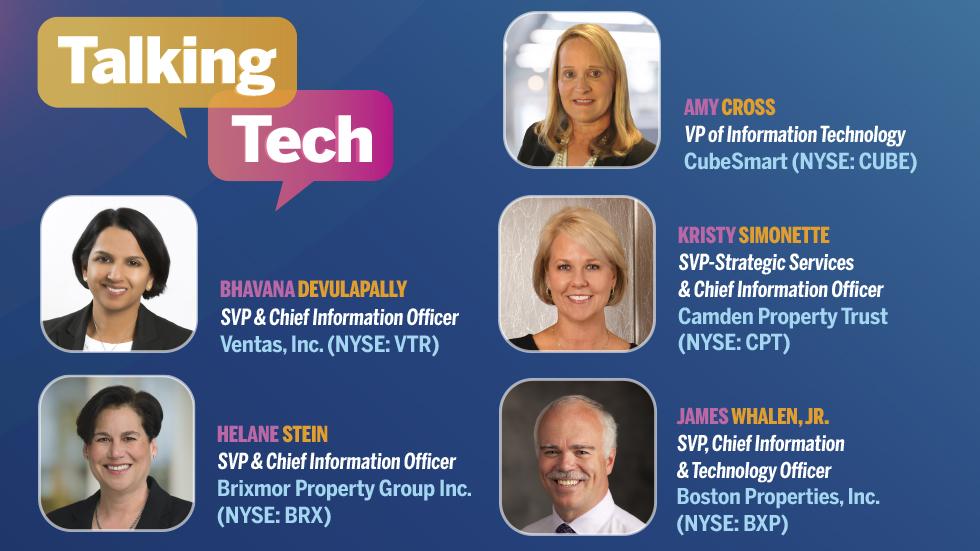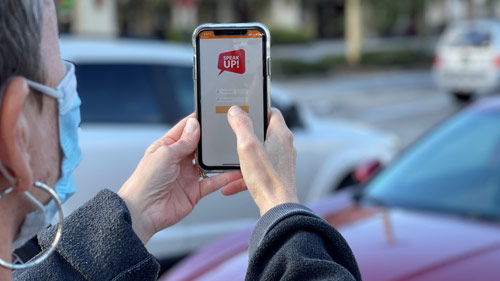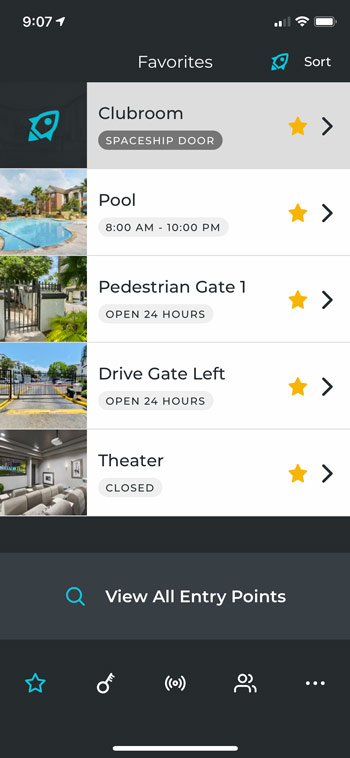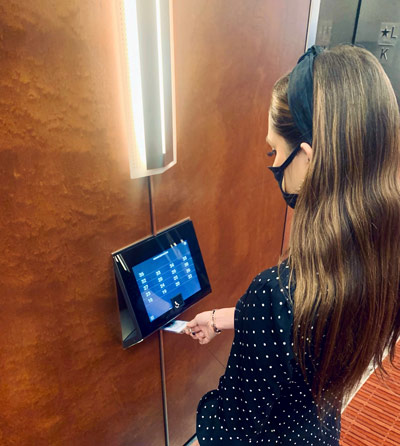REIT executives discuss how real estate is embracing technology across the property spectrum.

ITechnology’s imprint on our daily lives has become more pronounced than ever during the past year. For the experts responsible for technology and information systems at REITs around the nation, staying ahead of the curve in 2021 will mean continuing to innovate, sorting through and adopting emerging technologies, and continuing to adapt to the impact of COVID-19 on operations.
REIT magazine recently spoke with five REIT technology executives to assess how real estate is embracing technology across various sectors, why real estate technology adoption may have lagged other industries, and where some of the challenges and opportunities lie ahead.
How does technology, and more specifically your role, fit within the organization as a whole?
Amy Cross: I spent my career primarily in other customer industries—mainly hospitality, retail, and entertainment. “When I joined CubeSmart, I was tasked with taking the solid foundation that we had in-place and enhancing it to ensure we could scale our customer-centric model as we continue to grow.” Building upon our foundation has allowed us to innovate faster and in meaningful ways.
I was really excited about introducing CubeSmart to many of the innovations customers were already experiencing in other industries. Storage predominantly has been behind other industries, so having that background and bringing that insight to CubeSmart has been great.
Bhavana Devulapally: I was fortunate to inherit a great team and stable systems. My initial focus was to take a fresh look coming in from the outside on where we could modernize our portfolio—how we could enhance how we work with other functions so we could shift more of our time to the most impactful work.
A few months after I joined, I was able to bring the business transformation team into my department, and that was a great way to bring together the business and technology changes needed to make meaningful, sustainable growth and change. Then 2020 hit, and it’s been first and foremost about operational continuity in light of the pandemic, while still continuing to make progress against the strategies we set last year.
Kristy Simonette: I joined Camden in information technology, managing our property management software implementation. I was promoted to vice president, and still had the property management software responsibilities under me, but I also had ancillary income, purchasing—an array of shared services. Nine years ago, I was promoted to senior vice president, which consolidated information technology, our marketing group, and our internal contact center under my oversight.
Helane Stein: I joined Brixmor shortly after the company went public. My role was to take inventory of the current technology infrastructure, identify any gaps, introduce new tools, and integrate all platforms in order to give employees better transparency into their business operations.
Now that employees have tools to optimize their business intelligence and processes, my role evolved to provide “ubiquitous, frictionless IT,” or the ability to do your job on any device, anywhere.
James Whalen, Jr.: My first years at Boston Properties were very focused on establishing a platform to simply operate as a public company. Now, 22 years later, the role has significantly transformed, especially accelerating over the last 10 years.
We support the business in three buckets. The first is running company functions, like accounting and finance systems, phones, and everything tech that supports our talent and teams. If I went back 10 years, I was probably spending 80% to 90% of my time in this area. The second is the increasing integration of tech into the fabric of our buildings, with projects focused on improving the experience for occupants and guests, from access control to simple Wi-Fi.
The last bucket is what I call the Internet of Things of a building. That includes all of the unseen devices that keep a property humming, and cybersecurity is really a primary focus there. My job is now equally divided across all three buckets.
What are some of the primary ways technology is being used at your company?
Devulapally: Technology is embedded into pretty much all of our functions, but there are three key areas. The first is operational efficiencies, especially automation. That’s always been a very traditional use case, but it’s gone beyond just cost savings to technology that enables people to do their best work.
The second is around insights through data and analytics. We are a very data-driven company, and the amount of data out there has been growing at an astounding rate, so distilling that and giving us the visibility to key information for decisions and managing performance and getting this data in a consumable manner is an area we’re very focused on.
Finally, the property management and building technologies areas—how we interact with prospective and current tenants, how we manage the buildings themselves.
Cross: We’ve spent a number of years building out a custom point-of-sale system to serve as the hub of our organization. It’s where all of our store teammates transact with the customers to ensure a consistent customer experience across all of our stores.
Typically, in storage, you’d find providers having different systems across the store portfolio. Because we have this foundation in place, we’ve been able to accelerate our innovation on top of it. In addition, we equip our teammates with technology solutions that make their jobs even more efficient and keep them connected with each other and with our customers.
Simonette: We’ve invested heavily over the last three years in converting our entire organization to cloud technologies, including Oracle Cloud. We leverage Oracle for our human capital side, as well as the financial side to take care of connecting all the dots with all our back-office systems. For on-site, we use RealPage, Inc.’s CommunityConnect Smart Access controls, which we think does a great job of handling the needs of our maintenance staff, in particular.
Stein: Internally, we’ve seen a greater demand for ubiquitous tools where you can work anywhere on any device. Mobile applications for inspecting properties, managing construction projects, and electronic signature of documents are essential. Collaborative tools, such as Microsoft Teams and Zoom, are essential for both internal and external innovation.
The use of advanced data analytics, robotic process automation, and artificial intelligence (AI) is increasing, which provides actionable insight, greater transparency into operations, and greater agility in adapting to changes in the environment.
Whalen: Boston Properties has always been a data-driven culture, and we’ve been on a data journey for the last 10-plus years, elevating our skills and toolsets. These capabilities are now being integrated into how we run our buildings.
Data is one element of how we execute our sustainability strategy. Occupant/guest experience is another significant area of focus. As a multi-tenant office owner, we control common space and amenities and what technologies get overlaid to enable and enhance how our customers move through space. Another area of focus is what I call ESG amplified, which is now being accelerated by COVID. These macro-trends—data, occupant/guest experience, ESG—will all continue to be transformative.
How has COVID-19 impacted your company’s technology strategy or priorities?
Simonette: We already had self-guided tours and virtual tours on our road map. Three years ago, we knew it was the wave of the future that people would want to come at their leisure to tour our properties. COVID accelerated everything about self-guided tours.
Cross: “We adjusted our rental experience to be a mobile-first approach, allowing for a completely contactless experience. Renting with us can be done on a phone, laptop, or tablet. In addition, we also installed tablets in our stores for our customers to use to complete their rental if they are unable to do so on their own device prior to arriving at the store.”.
Devulapally: As the pandemic hit, our first priority was to get everyone working remotely so they could be safe. We were able to do this very successfully with little notice because our environment has been structured in a way to allow secure access for all of our employees from anywhere, so we had a really good head start on things.
From a longer-term view, the impact of the pandemic warranted another look at our cloud strategy. We had already been on a path to move more to the cloud before the pandemic. These events validated our strategy, so we’re continuing progress along that path.
Stein: One challenge we faced was how to ensure our centers were properly maintained when our property managers were not able to travel. So, we mobilized a team of employee volunteers to visit properties they lived near, reporting on property conditions using a custom app we already had in place.
Whalen: We’ve been able to address health security and safety and put in place effective measures and protocols, including technology solutions, to create a safe and trusted environment. We have thermal cameras and touchless technologies that were overlaid to buttress the health security measures and protocols in place across the portfolio.
Why has the real estate industry lagged somewhat in the adoption of new technology?
Cross: I come from other industries, where there are so many off-the-shelf solutions. In storage, it’s common to see folks build their own systems. Because of the unique requirements and unique state laws and regulations, it’s hard to find something off the shelf that meets your business needs.
The other piece is demand. When you go to Starbucks, a customer is incented to use the mobile app. But when you think about our space, will a customer use our mobile app when they only come in to see their goods every couple of months? It’s a different dynamic and a different customer. Therefore, we have to think differently about the purpose for each innovation we deliver and the value it provides.
Whalen: In general, the industry is very focused on transactions, buying and selling buildings, leasing space. The appreciation of how technology drives your business for competitive advantage can take a back seat to the transactional nature of the industry. I think it’s significantly changed in the last 10 years with PropTech and the inflows of capital supporting innovation for our industry and, more importantly, the adoption of technology across the entire built environment.
Stein: Traditionally, buying real estate took priority over technology investments. But over the last 10 years, a shift in expenditures has occurred as companies see the value and necessity of technology in driving business performance and operations.
Have you adopted any emerging technologies?
Simonette: We’re just scratching the surface on what we’re doing with AI and machine learning. We’ve been using AI in different places. We use it in our contact center and to facilitate the sales process. We’re looking for every opportunity we can to leverage AI to make us more efficient, but we don’t want to just introduce new pieces of technology where they don’t make sense. Whether it’s automated marketing campaigns or understanding the trends of the customer’s life cycle, we’re evaluating everything we can and implementing AI where it makes sense.
Stein: We’ve used AI for internal reporting. Based upon our product type of open-air centers, there is not as much use for the Internet of Things as the enclosed malls. As COVID has shown, it is not necessary to have the most cutting-edge technology, but more important to be mobile, integrated, and easy to use.
Whalen: We have done a number of engagements around AI and machine learning. It’s all about data and leveraging these new capabilities for greater actionable insights into how you run your business or serve your customers.
What are some of the biggest tech-related challenges and opportunities that lie ahead for the real estate industry?
Cross: We’re very innovative in our thinking, and I’m excited to think about the future. At the end of the day, I think the storage industry is ripe for innovation, and we’re looking more at some of these disruptive technologies that other industries are leveraging.
Devulapally: Some of the near-term challenges and opportunities are about post-pandemic navigating toward a new normal. The expectations of tenants, especially on the commercial side, are going to shift toward more expectation around consumer-like interactions through technology. Data is a huge opportunity going forward.
Simonette: There are many emerging technologies. The challenge is about finding the right fit and what makes sense in terms of what you introduce into your ecosystem.
With the pandemic, people have learned remote work is an actual possibility, so our residents are staying in our buildings 24 hours a day. Figuring out what is the right design, how we activate a building in the right way, what are the meaningful shared spaces, how do people want to use them—what is it that people want from our communities? That’s going to be the takeaway from COVID.
Stein: For challenges, it goes back to how we continue to provide the information that people need at their fingertips in the form they prefer. With the expansive amount of information, how do we make that actionable, whether that’s through AI, standard reporting, or another medium.
Whalen: I’m excited about the opportunities around sustainability and ESG reinforced by societal dynamics, customer expectations, and regulatory drivers. What that roadmap looks like for the coming decade will be a continuing and exciting journey. We talk about carbon neutrality and achieving that at some date in the future. It’s both an opportunity and a challenge.
Finally, are there any other tech issues that you think will impact REITs in the coming year?
Devulapally: This past year really showcased just how adaptable people can be. Through necessity, it created a real openness and acceptance of doing things differently. We can look at that and think about how we can accelerate some of the adoption of technology, where appropriate, in the industry. Cyber threats continue to be top of mind. We have to keep those in check and be aware.
Simonette: How are we going to adjust for 5G? Are our buildings ready? How will it change how our customers interact with one another and with us? 5G is a big question mark. As data demands get heavier, how do we make sure we provide buildings that facilitate wireless service? No one has landlines, they rely on Wi-Fi to have speedy internet. We’re always challenged by that.


